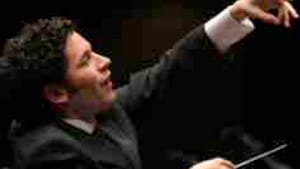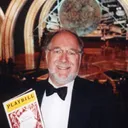Stay in the Loop
BSR publishes on a weekly schedule, with an email newsletter every Wednesday and Thursday morning. There’s no paywall, and subscribing is always free.
Excitement, in more ways than one
LA Philharmonic visits Verizon Hall (2nd review)

The first half of Gustavo Dudamel's concert with the Los Angeles Philharmonic at the Kimmel Center was an event, and the second half was an Event with a capital E.
The first half attraction was the East Coast premiere of John Adams's City Noir, a substantial piece by one of today's most prominent composers. Naturally, it deserves discussion. More unexpectedly, the old warhorse that comprised the concert's second half grabbed attention because of Dudamel's in-your-face interpretation.
The Adams piece was commissioned, in part, by the Los Angeles Philharmonic as a calling card for its new, 29-year-old conductor at the start of his tenure last October. Adams has become famous for his current-events operas, like Nixon in China, The Death of Klinghoffer and Doctor Atomic. In these works, his political viewpoint sometimes distracts from his musical gifts. In City Noir, Adams shows how far he has progressed in his instrumental writing, going far beyond the minimalism and repeated phrases of some of his early pieces.
He evokes the world of Los Angeles in the 1940s, when film noir was that city's best-known product. Picture Jack Nicholson and Faye Dunaway in Chinatown, or Clifton Webb obsessing over a dead woman in Laura. Adams successfully captures that mood and expands upon it. The 30-minute piece is a tone poem that makes use of a large orchestra, including temple block, bongos, castanets, chimes, cowbell, glockenspiel, marimba, vibraphone, xylophone, tambourine, tam tams and gongs.
Homage to Psycho
Adams pays tribute to film composers such as David Raksin (who wrote the score for Laura) and Bernard Hermann (Psycho and Vertigo) while incorporating tricks from 20th-Century symphonists such as Ives, Scriabin, Milhaud and Hovhannes.
Murmuring and scurrying figures are developed into broad melodies propelled by jazzy percussion. Important contributions by drummer, trombonist and alto sax player reflect the popular music of that era, and their solo passages are summed up in an ingenious cadenza for viola at the end of the second movement.
Your reaction to City Noir is likely to parallel your feelings about movie music. Some listeners enjoy a cult-like obsession with this genre; but for others, soundtrack music is as dull as elevator music. City Noir commendably provides an objective look at the genre. It doesn't demand your passionate commitment to the art form— merely that you understand its roots and are willing to explore the territory. The verdict: An interesting and enjoyable piece.
Compared to Ormandy…
The evening's real surprise, however, was Dudamel's unusual rendition of a piece that orchestra subscribers take for granted. Philadelphians especially are utterly familiar with Tchaikovsky Symphony No. 6. Eugene Ormandy gave many lush performances of it during his 44 years with the Philadelphia Orchestra, while Christopher Eschenbach furnished more tortured readings.
Dudamel, by contrast, made you sit up with an intense interpretation. He dug into the symphony's deep E-minor opening chords so that it conjured primordial feelings, almost resembling the opening of Wagner's Das Rheingold.
From that point on, Dudamel never let up, underlining nearly every moment and calling attention to passages that normally seem less important. Sometimes the accompanying brass figures seized attention over the main string melodies.
The best part was the galvanic march of the third movement. It was so exciting that I couldn't blame the audience for breaking the normal rule against applause between movements.
Strong feelings
Less effective was the waltz-like second movement, which wasn't as lilting as it could be. The fourth movement was emphatic, not portraying quiet resignation as much as abject despair. Dudamel obviously has strong feelings about the piece, and he laid them out vividly.
Dudamel attracted publicity because of his youth and his quick rise to prominence. Now a reaction is taking place where critics dismiss the impact of curly hair and a smile. This concert proved that Dudamel doesn't rely on surface appearances alone— that he can also create excitement in the way he presents music.♦
To read another review by Dan Rottenberg, click here.
The first half attraction was the East Coast premiere of John Adams's City Noir, a substantial piece by one of today's most prominent composers. Naturally, it deserves discussion. More unexpectedly, the old warhorse that comprised the concert's second half grabbed attention because of Dudamel's in-your-face interpretation.
The Adams piece was commissioned, in part, by the Los Angeles Philharmonic as a calling card for its new, 29-year-old conductor at the start of his tenure last October. Adams has become famous for his current-events operas, like Nixon in China, The Death of Klinghoffer and Doctor Atomic. In these works, his political viewpoint sometimes distracts from his musical gifts. In City Noir, Adams shows how far he has progressed in his instrumental writing, going far beyond the minimalism and repeated phrases of some of his early pieces.
He evokes the world of Los Angeles in the 1940s, when film noir was that city's best-known product. Picture Jack Nicholson and Faye Dunaway in Chinatown, or Clifton Webb obsessing over a dead woman in Laura. Adams successfully captures that mood and expands upon it. The 30-minute piece is a tone poem that makes use of a large orchestra, including temple block, bongos, castanets, chimes, cowbell, glockenspiel, marimba, vibraphone, xylophone, tambourine, tam tams and gongs.
Homage to Psycho
Adams pays tribute to film composers such as David Raksin (who wrote the score for Laura) and Bernard Hermann (Psycho and Vertigo) while incorporating tricks from 20th-Century symphonists such as Ives, Scriabin, Milhaud and Hovhannes.
Murmuring and scurrying figures are developed into broad melodies propelled by jazzy percussion. Important contributions by drummer, trombonist and alto sax player reflect the popular music of that era, and their solo passages are summed up in an ingenious cadenza for viola at the end of the second movement.
Your reaction to City Noir is likely to parallel your feelings about movie music. Some listeners enjoy a cult-like obsession with this genre; but for others, soundtrack music is as dull as elevator music. City Noir commendably provides an objective look at the genre. It doesn't demand your passionate commitment to the art form— merely that you understand its roots and are willing to explore the territory. The verdict: An interesting and enjoyable piece.
Compared to Ormandy…
The evening's real surprise, however, was Dudamel's unusual rendition of a piece that orchestra subscribers take for granted. Philadelphians especially are utterly familiar with Tchaikovsky Symphony No. 6. Eugene Ormandy gave many lush performances of it during his 44 years with the Philadelphia Orchestra, while Christopher Eschenbach furnished more tortured readings.
Dudamel, by contrast, made you sit up with an intense interpretation. He dug into the symphony's deep E-minor opening chords so that it conjured primordial feelings, almost resembling the opening of Wagner's Das Rheingold.
From that point on, Dudamel never let up, underlining nearly every moment and calling attention to passages that normally seem less important. Sometimes the accompanying brass figures seized attention over the main string melodies.
The best part was the galvanic march of the third movement. It was so exciting that I couldn't blame the audience for breaking the normal rule against applause between movements.
Strong feelings
Less effective was the waltz-like second movement, which wasn't as lilting as it could be. The fourth movement was emphatic, not portraying quiet resignation as much as abject despair. Dudamel obviously has strong feelings about the piece, and he laid them out vividly.
Dudamel attracted publicity because of his youth and his quick rise to prominence. Now a reaction is taking place where critics dismiss the impact of curly hair and a smile. This concert proved that Dudamel doesn't rely on surface appearances alone— that he can also create excitement in the way he presents music.♦
To read another review by Dan Rottenberg, click here.
What, When, Where
Los Angeles Philharmonic: Adams, City Noir; Tchaikovsky, Sixth Symphony (“Pathétiqueâ€). Gustavo Dudamel, conductor. May 19, 2010 at Verizon Hall, Kimmel Center, Broad and Spruce Sts. (212) 790-5800 or www.kimmelcenter.org.
Sign up for our newsletter
All of the week's new articles, all in one place. Sign up for the free weekly BSR newsletters, and don't miss a conversation.

 Steve Cohen
Steve Cohen